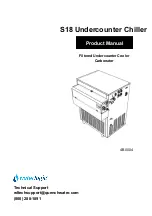
30
8 - WATER CONNECTIONS
When connecting units to the water distribution pipe work,
refer to the certified dimensional drawings supplied with the
unit for the dimensions and position of the exchanger water
inlet and outlet connections.
The piping must not transmit any axial or radial force to the
exchangers, or any vibrations.
The water supply must be analysed and the circuit created
must include the required water treatment elements: filters,
additives, intermediate exchangers, bleed devices, vents, shut-
off valves, etc., according to the results, to prevent corrosion
(for example, damage to the tube protective surface if there
is contamination in the fluid), fouling and deterioration of the
pump lining
Before any start-up, make sure the heat-transfer fluid is
compatible with the water circuit materials and coating. Where
additives or fluids other than those recommended by the
manufacturer are used, ensure that these are not considered
gases, and that they are class 2, as defined in directive 2014/68/
EU.
Manufacturer's recommendations concerning heat-transfer
fluids:
•
No NH
4
+
ammonium ions in the water - these are very harmful
to copper. This is one of the most important factors for the
operating life of copper piping. A content of several tenths
of mg/l will badly corrode the copper over time.
•
Cl- Chloride ions are also harmful to copper with a risk of
perforating corrosion. Keep at a level below 125 mg/l.
•
SO
4
sulphate ions can cause perforating corrosion if their
content is above 30 mg/l.
•
No fluoride ions (<0.1 mg/l).
•
No Fe
2+
and Fe
3+
ions with non-negligible levels of dissolved
oxygen must be present. Dissolved iron < 5 mg/l with
dissolved oxygen < 5 mg/l.
•
Dissolved silica: silica is an acid element of water and can
also lead to corrosion risks. Content < 1 mg/l.
•
Water hardness: >0.5 mmol/l. Values between 1 and 2.5 are
recommended. This will facilitate scale deposit that can limit
corrosion of copper. Values that are too high can cause piping
blockage over time. A total alkalimetric titre (TAC) below
100 mg/l is desirable.
•
Dissolved oxygen: Avoid any sudden change in water
oxygenation conditions. It is as detrimental to deoxygenate
the water by mixing it with inert gas as it is to over-oxygenate
it by mixing it with pure oxygen. The disturbance of the
oxygenation conditions encourages destabilization of copper
hydroxides and the release of particles.
•
Electrical conductivity 10-600 µS/cm.
•
pH: Ideal case pH neutral at 20-25°C (7.5 < pH < 9).
Filling, topping up or emptying of the water circuit
must be carried out by qualified personnel using the
air bleed devices and tools and equipment suitable
for the products.
The heat-transfer fluid should be filled and drained
using devices fitted to the water circuit by the
installer. Never use the unit heat exchangers to add
heat-transfer fluid.
8.1 - Operating precautions and recommendations
Before system start-up, make sure the hydraulic circuits are
connected to the appropriate heat exchangers.
The water circuit must have as few bends and horizontal
sections at different levels as possible,
Main points to be checked for the connection:
•
Ensure that the stainless steel water filter is present in
the screen filter. See figure 2.
•
Observe the water inlet and outlet connections shown on the
unit.
•
Install manual or automatic air purge valves at all high points
in the circuit.
•
Maintain the pressure of the circuit(s) with a pressure-
reducing valve and install a relief valve and an expansion
vessel. Units supplied with a hydraulic module include a valve.
The expansion vessel is supplied as an option.
•
Install thermometers in both the water inlet and outlet pipes.
•
Install drain connections at all low points to allow the whole
circuit to be drained.
•
Install shut-off valves close to the water inlet and outlet
connections.
•
Use flexible connections to reduce the transmission of
vibrations.
•
Insulate the cold water pipework, after testing for leaks, to
prevent heat transmission and condensation.
•
Cover the insulation with a vapour barrier. If the water pipes
outside the unit pass through an area where the ambient
temperature is likely to fall below 0°C, it must be protected
against frost (antifreeze solution or electric heaters)
•
If there are particles in the fluid which are liable to foul the
exchanger, a screen filter must be installed upstream of the
pump. The mesh size of this filter must be 1.2 mm (see Typical
hydraulic installation diagram).
NOTE:
A screen filter must be installed for units supplied without a
hydraulic module. This must be installed on the unit's water
inlet pipe, as close as possible to the unit heat exchanger. It
must be located somewhere easily accessible to enable
disassembly and cleaning.
If the filter is missing, the plate heat exchanger can quickly
become fouled during the first start-up, as it will trap any
debris in the system, and correct unit operation will be
affected (reduced water flow rate due to the increased pressure
drop).
•
Do not introduce any excessive static or dynamic pressure
into the heat exchange circuit (with regard to the design
operating pressures).
•
Products used for thermal insulation of recipients during
hydraulic connection must be chemically neutral to the
surfaces on which they are applied. All original materials
supplied by the manufacturer comply with this
requirement.
Содержание 30RBM 160
Страница 75: ......
















































